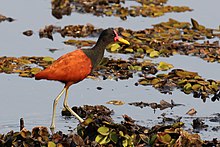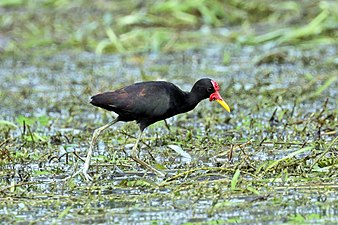Wattled jacana
| Wattled jacana | |
|---|---|

| |
| Adult J. j. jacana the Pantanal, Brazil | |
| Scientific classification | |
| Domain: | Eukaryota |
| Kingdom: | Animalia |
| Phylum: | Chordata |
| Class: | Aves |
| Order: | Charadriiformes |
| Family: | Jacanidae |
| Genus: | Jacana |
| Species: | J. jacana
|
| Binomial name | |
| Jacana jacana (Linnaeus, 1766)
| |
| Synonyms | |
|
Parra jacana Linnaeus, 1766 | |
This article includes a list of general references, but it lacks sufficient corresponding inline citations. (March 2013) |
The wattled jacana (Jacana jacana) is a wader which is a resident breeder from western Panama and Trinidad south through most of South America east of the Andes.
The jacanas are a group of wetland birds, which are identifiable by their huge feet and claws that enable them to walk on floating vegetation in the shallow lakes that are their preferred habitat. They are found worldwide within the tropical zone. For the origin and pronunciation of the name, see Jacana.
The wattled jacana lays four black-marked brown eggs in a floating nest. The male, as with other jacanas and some other wader families like the phalaropes, takes responsibility for incubation, with two eggs held between each wing and the breast. The females are polyandrous and will help to defend the nests of up to four mates.
These are conspicuous and unmistakable birds. They are 17–23 cm (6.7–9.1 in) long, but the females are larger than the males. The adults have a chestnut back and wing coverts, with the rest of the body mainly black. In flight the greenish yellow flight feathers are obvious. Also visible are yellow bony spurs on the leading edge of the wings, which it can use to defend itself and its young. The yellow bill extends up as a red coot-like head shield and a reddish wattle, and the legs and very long toes are dull blue-grey.
Young birds initially have entirely white underparts, and can always be identified by the presence of white in their plumage.
There are six subspecies, with the nominate J. j. jacana being the most widespread. Several of the other subspecies are similar, but J. j. hypomelaena of western Panama and northern Colombia has all the chestnut plumage replaced by black, and J. j. scapularis of western Ecuador has some black feathers on its chestnut shoulders, and white outer primary feathers.
Subspecies
- J. j. hypomelaena (Gray, 1846): west-central Panama to northern Colombia
- J. j. melanopygia (Sclater, 1857): western Colombia to western Venezuela
- J. j. intermedia (Sclater, 1857): north & central Venezuela
- J. j. jacana (Linnaeus, 1766): Trinidad, southern Colombia & southern Venezuela through the Guianas south to eastern Bolivia, northern Argentina & Uruguay
- J. j. scapularis (Chapman, 1922): western Ecuador & northwestern Peru
- J. j. peruviana (Zimmer, 1930): northeastern Peru & northwestern Brazil[2]
This species produces a range of noisy rattling calls.
The wattled jacana's food is insects, other invertebrates and seeds picked from the floating vegetation or the water's surface.
References
- ^ BirdLife International (2012). "Jacana jacana". IUCN Red List of Threatened Species. 2012. Retrieved 26 November 2013.
{{cite journal}}: Invalid|ref=harv(help) - ^ Gill, Frank; Donsker, David, eds. (2019). "Grebes, flamingos, buttonquail, plovers, painted-snipes, jacanas, plains-wanderer, seedsnipes". World Bird List Version 9.2. International Ornithologists' Union. Retrieved 26 June 2019.
- Hayman, Peter; Marchant, John; Prater, Tony (1991). Shorebirds: An Identification Guide to the Waders of the World. Houghton Mifflin Harcourt. ISBN 9780395602379.
- Hilty, Steven L. (2003). Birds of Venezuela. Princeton University Press. ISBN 0-7136-6418-5.
- ffrench, Richard; O'Neill, John Patton; Eckelberry, Don R. (1991). A Guide to the Birds of Trinidad and Tobago (2nd ed.). Ithaca, N.Y.: Comstock Publishing. ISBN 0-8014-9792-2.
External links
- BirdLife species factsheet for Jacana jacana
- "Wattled jacana media". Internet Bird Collection.
- Wattled jacana photo gallery at VIREO (Drexel University)
- Wattled jacana species account at Neotropical Birds (Cornell Lab of Ornithology)
- Interactive range map of Jacana jacana at IUCN Red List maps
- Audio recordings of Wattled jacana on Xeno-canto.







